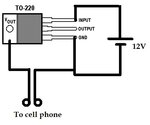jayanthyk192
Full Member level 3
Hi all,
I needed a 5V-3A regulator. So, I bought myself an LM1084. I built the simple circuit(attached). I measured the output voltage and found it to be 5V. I connected this to my cell phone to test and the IC started heating up badly. I measured the current and found it to be around 250mA. I dont understand this. Please help me figure out the problem.
The IC is a fixed voltage(5V) LM1084. I even had a small heat sink on.
Thank you.
I needed a 5V-3A regulator. So, I bought myself an LM1084. I built the simple circuit(attached). I measured the output voltage and found it to be 5V. I connected this to my cell phone to test and the IC started heating up badly. I measured the current and found it to be around 250mA. I dont understand this. Please help me figure out the problem.
The IC is a fixed voltage(5V) LM1084. I even had a small heat sink on.
Thank you.

